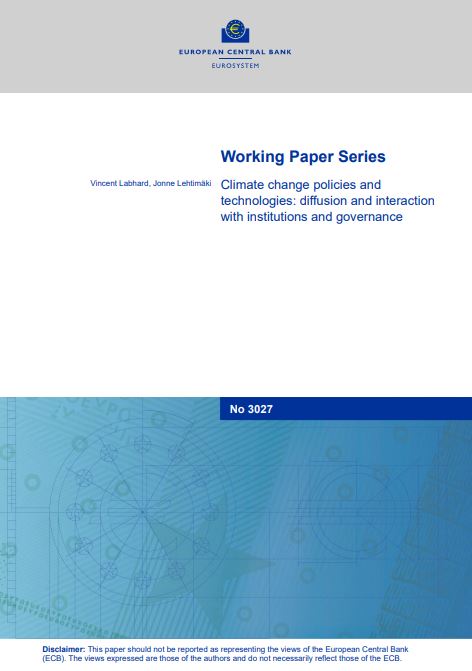
□ 기후변화 대응은 적응(adaptation)과 완화(mitigation)로 나뉘며, 각각의 정책과 기술은 확산 경로와 속도에서 차이를 보임. 보고서는 이 두 측면을 모두 고려하면서, 특허 출원, 탄소세, CO₂ 배출량, 환경세, 정책 강도 지수(EPS) 등 다양한 지표를 사용해 확산 수준을 측정함. 분석 결과, 제도와 거버넌스의 질이 높을수록 정책과 기술의 확산 속도와 범위가 모두 커지는 경향이 있음을 보여줌
□ 특히, 정부의 정책 실행 역량(정책 수립과 이행 능력)과 정치적 안정성, 법치, 부패 통제 등은 기술 확산에 강한 영향을 미침. 반면, 환경세 등 일부 정책은 제도적 품질과 상관관계가 약하거나 일관되지 않은 결과를 보였으며, 정책보다는 기술의 확산에서 제도적 영향이 더 뚜렷하게 나타남. 이는 제도가 잘 갖춰진 국가일수록 새로운 기술을 빠르게 받아들이고 활용하는 기반이 잘 마련되어 있음을 의미함
□ 또한 확산의 양상은 단순한 증가가 아닌, 네트워크 효과와 사회적 학습이 반영된 S자 곡선(S-curve) 형태를 따르는 것으로 나타남. 초기에 느리게 시작하다가 임계점을 넘으면 급격히 확산되는 방식임. 이러한 확산 모델은 디지털 기술의 확산과 유사한 구조를 보이며, 기후기술과 정책도 비슷한 방식으로 전파된다고 설명함
□ 결론적으로, 보고서는 기후변화 대응을 위한 정책 효과를 극대화하려면 기술 개발과 함께 제도적 기반 강화가 필수임을 강조함. 특히 각국의 제도와 거버넌스 수준이 확산에 미치는 영향을 고려하여, 정책 설계 시 ‘속도’와 ‘범위’를 분리하여 평가하는 접근이 필요함을 시사함. 이는 기후위기 대응의 효과성과 형평성을 높이기 위한 실질적 전략적 방향성을 제공함
목차
Title page 1
Contents 1
Abstract 2
Non-Technical Summary 3
1. Introduction 5
2. Theory and Models 6
2.1. The Diffusion of Climate Policies and Technologies 6
2.2. The Appropriate Diffusion Model 7
2.3. The Connection to the Green Transition 8
2.4. The Interplay with Institutions and Governance 9
3. Data 9
3.1. Sources, Sample and Countries 9
3.2. Climate Change Policies and Technologies 10
3.3. Institutions and Governance 13
3.4. Control Variables 15
4. Methodology 16
5. Results 19
5.1. Specific Climate Change Policies and Technologies (CCPTs) 19
5.2. CCPs as captured by the EPS 24
5.3. The relationships of CCTPs to the EPS 25
5.4. The role of different aspects of institutions and governance 27
6. Conclusions 29
References 30
Appendix 34
A. Countries and Country Groupings 34
B. Data Description and Sources 35
C. Results for other institutions and governance variables 38
Acknowledgements 43
Tables 11
Table 1. Descriptive statistics of variables capturing CCPTs 11
Table 2. Descriptive statistics of institutional variables 15
Table 3. Descriptive statistics of control variables 16
Table 4. CCATs (patents, environmentally-related technologies) 20
Table 5. CCMTs (patents, climate-change technologies) 21
Table 6. CCAPs (CO₂ emissions) 22
Table 7. CCMPs (environmentally-related taxes) 23
Table 8. CCPs (EPS) 25
Table 9. Correlations of CCTPs with EPS 26
Table 10. Effect of EPS on other variables 26
Table 11. Aspects of institutions and governance 28
Figures 12
Figure 1. The diffusion of Climate Change Technologies and Policies 12
Figure 2. Worldwide Governance Indicators and the summary measures 14
Figure 3. Diffusion of CCPs 17
Appendix Tables 34
Table A.1. Countries and Country Groupings 34
Table B.1. Variables 35
Table C.1. CCATs (patents, environmentally-related technologies) 38
Table C.2. CCMTs (patents, climate change technologies) 39
Table C.3. CCAPs (CO₂ emissions per capita) 40
Table C.4. CCMPs (environmentally-related taxes) 41
Table C.5. EPS (Environmental Policy Stringency Index) 42
Appendix Figures 36
Figure B.1. Diffusion of CCTPs 36


